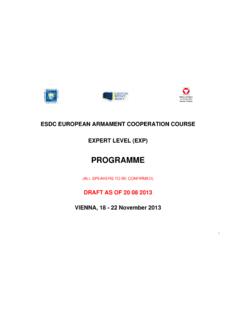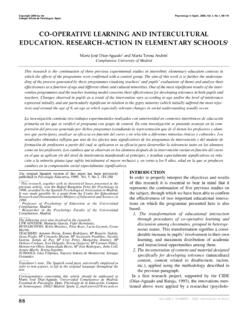Transcription of Co-operative renewable energy in the UK
1 Co-operative renewable energy in the UKA guide to this growing sectorRebecca Willis and Jenny WillisAbout the authorsRebecca Willis is an independent researcher. Her work focuses on environmental politics and policymaking at both a national and local level. Rebecca convenes Green Alliance s Climate Leadership programme for MPs, and advises the Lake District National Park on climate change. In May 2011 she was appointed as a Council Member of the Natural Environment research Council. From 2004-11 Rebecca was Vice-Chair of the UK Sustainable Development Commission. In 2008-9, she was a judge of Nesta s Big Green Challenge, a community carbon-cutting competition. She is on the advisory board of the Community Innovation in Sustainable energy research programme at the University of Willis is an independent action research practitioner with extensive experience in the field of participation, research and stakeholder engagement.
2 She specialises in working with groups exploring significant and critical change, such as older people reflecting on the design and impact of housing policies, and communities in West Cumbria considering the possibility of siting a repository for radioactive waste. She has previously carried out other action research projects for the Crown Prosecution Service, National Centre for Independent Living, Social Care Institute for Excellence, General Social Care Council and the Equalities and Human Rights would like to thank all those people from the community energy projects, and others with a stake in community energy , who spent precious time talking to us about their experiences and vision for the future.
3 We would also like to thank all those who attended summit events to help inform our report was commissioned by The Co-operative Group. All views contained within are attributable to the author and do not necessarily reflect those of The Co-operative were kindly provided by David McHugh, (pages 8, 10, 12, 17 and 36), Bill Truin (page 19), Martin Phelps (images of Westmill Wind Farm Co-op, pages 13, 16 and 18), Energy4 All (image of Fenland Green Power Co-op, page 30), Ian Robinson (Page 22), Green energy Nayland (Page 23, 25, 34 and 38)Published 20123Co- operative renewable energ y in the UK: a guide to this growing sector Contents4 Foreword5 Introduction6 The basics6 What is a Co-operative ?
4 6 How do energy co-operatives work?7 What makes a successful energy Co-operative ?8 Co-operative case study: Ouse Valley energy Service Company Ltd (OVESCo)12 What have the co-operatives achieved?13 Co-operative case study: Cwm Arian renewable energy (CARE)17 The economics of renewable energy co-operatives19 Co-operative case study: River Bain Hydro23 The advantages of choosing a Co-operative structure25 Co-operative case study: Green energy Nayland (GEN)29 The challenges of choosing a Co-operative structure30 Co-operative case study: Valley Wind Co-operative34 Main learning points 34 Shifting regulatory environment34 Access to finance 35 Limitations and restrictions of funding35 Planning and legislative hurdles36 Finding a site36 Motivation and time37 Support and information39 Glossary of terms and abbreviationsRebecca Willis and Jenny Willis4 ForewordRenewable energ y co-operatives are on the rise with over 30 having registered since 2008.
5 The number of trading energ y generation co-operatives has reached 19, and these have achieved a wholly owned generation capacity of and part ownership in a further of capacity through investment in larger, commercial further energy co-operatives are at launch stage and a further 16 are in the process of, or planning to, undertake feasibility studies. Should all succeed they will bring online a further of generation terms of the UK s current energy needs this is a drop in the ocean, but what we see in this report is a picture of inspiring, local communities coming together to start and run energy generation co-operatives, often in the face of significant a leading provider of support for Co-operative businesses in the UK, we see the beginnings of a revolution in the way that we generate our energy .
6 Through our Co-operative Enterprise Hub, which provides free business support for new and existing co-operatives, we have earmarked 1 million to support the establishment of new renewable energy co-operatives. Moreover, as a market leader in finance for renewable energy projects, The Co-operative Bank has pledged 1 billion of support with over 500 million already move from an inspiring but tiny share of the energy generation market we must first understand what is holding this emerging sector back. Together with our colleagues at Co-operatives UK, the national trade body that campaigns for co-operation, we have spent time getting under the bonnet of five of these renewable energy co-operatives. We hope the results will be useful reading for communities thinking of following a similar path, for policy makers interested in the challenges these communities faced and for anyone else who wants to gain a deeper understanding of this exciting Monaghan Head of Social Goals and Sustainability The Co-operative Group5Co- operative renewable energ y in the UK: a guide to this growing sector IntroductionCo-operatively-owned energ y generation is a vibrant and growing sector in the UK.
7 The first co-operatively-owned wind turbines, Baywind in Cumbria, started turning in 1997. Since then, over 7,000 individual investors have ploughed over 16 million into community-owned wind turbines. With the advent of feed-in tariffs (FITs), smaller schemes have grown in number too, though the FITs reviews in April and November 2011 have posed significant challenges, with some new plans now on report summarises insights gained from visits to five co-operatively owned energy projects during the summer of 2011. The research and report writing were carried out before the November 2011 FITs review. Ongoing work by the Co-operative Group and Co-operatives UK will examine the co-operatives are: Cwm Arian renewable energy (CARE) A proposed wind development in West Wales.
8 Green energy Nayland (GEN) A 15kW solar photovoltaic installation on the roof of a primary school in Nayland, Suffolk. Ouse Valley energy Company (OVESCo) A 98kW solar photovoltaic installation on the roof of a local brewery warehouse in Lewes, East Sussex. River Bain Hydro A 45 kW hydro scheme in Bainbridge, North Yorkshire. Valley Wind A proposed 6MW wind development in the Colne Valley, West Yorkshire. In this report we take a look at what makes a successful energy Co-operative , what the groups have achieved and the impact of Co-operative models for energy . This report is intended as a learning tool, so we also run through the challenges of setting up and running such an energy co-operatives in the UKScotland 4 trading 1 pre-launchEngland 14 trading 8 launch 14 pre-launchWales 1 trading 1 pre-launchRebecca Willis and Jenny Willis6 The basicsWhat is a Co-operative ?
9 Co-operative businesses are owned and run by and for their members, whether they are customers, employees or residents. As well as giving members an equal say and share of the profits, co-operatives act together to build a better are a flexible alternative business model. They can be set up in different ways, using different legal structures, depending on what works for the members. The definition of a Co-operative business is that they are owned and run by the members - the people who benefit from the Co-operative s they carry out all kinds of business, all Co-operative businesses have core things in common. Co-operatives share their profitsCo-operatives want to trade successfully they are businesses, not charities, after all.
10 Members, such as farmers or freelancers, tenants or taxi drivers, can often do better by working together. And sharing the profit is a way to keep it fair and make it worthwhile. Rather than rewarding outside investors, a Co-operative shares its profits amongst the members and/or the local are owned by people like youA Co-operative is an alternative business model that exists to serve its members, whether they are the customers, the employees, or the local community. The members are the owners, with an equal say in what the Co-operative does. As well as getting the products and services they need, members help shape the decisions their Co-operative the UK, co-operatives are owned by nearly 13 million people and these numbers keep on growing.









